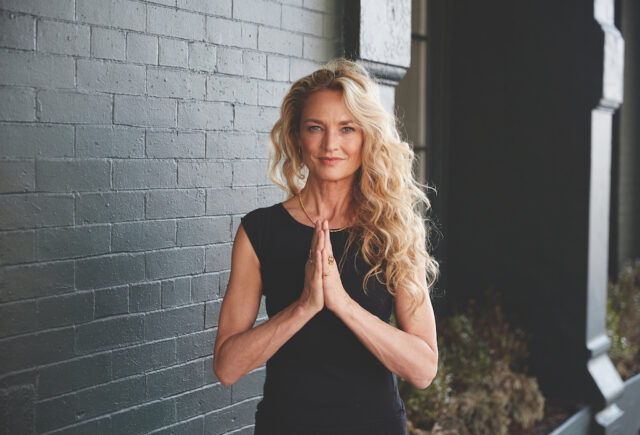
By Donna Bulseco
Twenty-five years ago, Colleen Saidman Yee had no intention of being a yoga teacher, despite her training at the now-legendary Jivamukti Yoga studio with founders Sharon Gannon and David Life. She had joined the Ford Modeling Agency as a model in 1980, and took her first yoga class in 1984, but felt ill-suited to standing in front of a group teaching a practice she found rigorous, spiritual and deeply satisfying. “I was way too green,” says Saidman, speaking via Zoom about the origins of Yoga Shanti, her Sag Harbor studio, and ticking off the long-ago justifications she voiced to her mentors that day: “For one, there’s chanting and I’m tone-deaf; second, I don’t like speaking in public. Plus, I’ve got a seizure disorder, so what about that?!”
Sometimes in life, even denial can lead to acceptance, but wisdom doesn’t come easily or without challenges. When Saidman got home, she found a message on her answering machine (remember those?) from Sharon Gannon. “She said, ‘You’re teaching my 6:15 class tonight. It’s sold out and I’ll be taking it,’ says Saidman. “I guess she knew what she was doing, throwing me off the cliff, because I still remember the yoga sequence I did. It was the first yoga class I taught, and I remember everything about it.”
In truth, Saidman has a steel-trap mind, and as a storyteller, she brings Yoga Shanti’s story alive in discrete, vivid details, recounting how in 1999, she and another Jivamukti teacher made the snap decision to open a yoga studio in Sag Harbor. “We went to an ATM, took out $500 each, and found a walk-up apartment behind Murf’s Backstreet Tavern on Division Street. It fit 22 students, was literally mat-to-mat-to-mat and busy from day one,” she says. “I still don’t know how people found out about us.”
After a year, the studio moved to Main Street, behind the kite store. “We could fit 35 people and it was like a sweatbox; our filing system was a recipe box!” Two years later, a move to Washington Street and an upgrade to a computer grew the business even more. After she and her then-business partner split, Saidman found the location on Bridge Street in 2009; the house was being built, so she could dictate the layout. “It’s like a jewel box,” she says, with pink and light orange walls, a gold-leaf ceiling, hand-carved borders and “an altar our son built”—the ‘our’ referring to her husband, Rodney Yee, a long-time leader in the world of yoga, who has been instrumental in bringing it into mainstream culture. The couple have four children: Evan, Adesha, Rachel and Johanna.
The altar holds pictures of influential people in her life, such as Mother Teresa, whom she worked with for a year; her own mother, “a highly spiritual person”; Pema Chödrön, a Buddhist nun; and Bob Dylan, whose “lyrics have meant so much to me since I was a young girl,” says Saidman. These deeply personal tributes are indicative of how Yoga Shanti welcomes and acknowledges those who walk in or sign in (for an online class) with a call to engage.
“The fruit of love is service, the fruit of service is peace,” says Saidman. She keeps that in mind as every class starts with a dedication, “where we bring to our heart someone who needs a little juice,” she says. “That dedication creates a dynamic that’s different from an intention, which is like a New Year’s resolution.” The idea is to be present, rather than intending to be present. “If I intend to balance in headstand, for example, it’s probably not going to happen,” she notes. Yoga Shanti is an evolution of all the study she and Yee have done, and blends the many influences inspiring them over the years. “Rodney brought with him the Iyengar training, which focuses on specific alignment and more of an engineering of the body. Rodney is an engineer of the body.”
Most of all, Yoga Shanti practice focuses on the safety of the joints, the spine and the nervous system. “We want people to leave our class alert, but relaxed, so it’s a balance.” Saidman also does a lot of work with women, creating specific sequences for self-esteem for those who are anxious or overwhelmed.
“The language of the body affects so much,” she says. “For instance, if you’re grieving or feeling sad, we need to meet you where you are. If there’s a global sadness going on, I would start you curled up in a ball, because that’s what your body wants to do at that time. I’m not going to start you draped over a bolster. We work step-by-step.” Saidman was pleased when she heard a young man felt as if he were “levitating” during a class.
Levitating: uplifted and lifted up. That was the mood, too, at the “epic” party the studio held this year in the studio’s parking lot on June 21—the summer solstice, the International Day of Yoga and a full moon. Six hundred people took class for free that day; the community joined in; guests snapped photos in front of a step-and-repeat screen with an image of Ganesha, the deity for overcoming obstacles and new beginnings. “It was exhausting to put on, but so heartwarming for the whole community,” Saidman says, especially for the local vendors and students who had toughed out the pandemic alongside them. “It was a sanctuary, a milestone after the last four years. Everyone was making toasts, and every time someone would hug me, I would cry,” she says.
Still gorgeous, having reached retirement age as a glowing endorsement for a lifelong commitment to yoga, mindfulness and kindness, Saidman often stops to praise those who inspired her along the way. Her personal sanctuary, it seems, resides in her resilience, plus loving and energetic commitment. “I’m a business owner, with a work ethic like my father, who worked at a factory and raised seven kids,” says Saidman. “I respond almost immediately.” yogashanti.com





